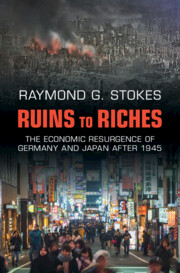Refine search
Actions for selected content:
26946 results in Economic history
Part IV - Navigating Waves of Globalization, 1990 to the Present
-
- Book:
- Ruins to Riches
- Published online:
- 12 April 2024
- Print publication:
- 09 May 2024, pp 203-284
-
- Chapter
- Export citation
Contents
-
- Book:
- Soldiers, Wages, and the Hellenistic Economies
- Published online:
- 21 May 2024
- Print publication:
- 09 May 2024, pp vii-viii
-
- Chapter
- Export citation
Part II - Making Miracles, 1950–1973
-
- Book:
- Ruins to Riches
- Published online:
- 12 April 2024
- Print publication:
- 09 May 2024, pp 57-136
-
- Chapter
- Export citation
Index
-
- Book:
- Soldiers, Wages, and the Hellenistic Economies
- Published online:
- 21 May 2024
- Print publication:
- 09 May 2024, pp 244-250
-
- Chapter
- Export citation
Contents
-
- Book:
- Ruins to Riches
- Published online:
- 12 April 2024
- Print publication:
- 09 May 2024, pp vii-viii
-
- Chapter
- Export citation
Bibliography
-
- Book:
- Soldiers, Wages, and the Hellenistic Economies
- Published online:
- 21 May 2024
- Print publication:
- 09 May 2024, pp 217-243
-
- Chapter
- Export citation
Notes
-
- Book:
- Ruins to Riches
- Published online:
- 12 April 2024
- Print publication:
- 09 May 2024, pp 285-317
-
- Chapter
- Export citation
Part I - No Mere Incantation
-
- Book:
- Ruins to Riches
- Published online:
- 12 April 2024
- Print publication:
- 09 May 2024, pp 11-56
-
- Chapter
- Export citation
2 - The Miracle Makers
- from Part I - No Mere Incantation
-
- Book:
- Ruins to Riches
- Published online:
- 12 April 2024
- Print publication:
- 09 May 2024, pp 35-56
-
- Chapter
- Export citation
List of Maps
-
- Book:
- Soldiers, Wages, and the Hellenistic Economies
- Published online:
- 21 May 2024
- Print publication:
- 09 May 2024, pp xx-xx
-
- Chapter
- Export citation
8 - The Hauntings of the Past
- from Part III - Sustaining Miracles, 1973–1989
-
- Book:
- Ruins to Riches
- Published online:
- 12 April 2024
- Print publication:
- 09 May 2024, pp 156-182
-
- Chapter
- Export citation
The fiscal transformation of the Spanish Carrera de Indias in the 17th century: a reinterpretation
-
- Journal:
- Revista de Historia Economica - Journal of Iberian and Latin American Economic History / Volume 42 / Issue 2 / September 2024
- Published online by Cambridge University Press:
- 15 April 2024, pp. 171-192
- Print publication:
- September 2024
-
- Article
-
- You have access
- Open access
- HTML
- Export citation

Ruins to Riches
- The Economic Resurgence of Germany and Japan after 1945
-
- Published online:
- 12 April 2024
- Print publication:
- 09 May 2024
1930: first modern crisis
-
- Journal:
- Financial History Review / Volume 30 / Issue 3 / December 2023
- Published online by Cambridge University Press:
- 08 April 2024, pp. 277-307
-
- Article
- Export citation
FHR volume 30 issue 3 Cover and Back matter
-
- Journal:
- Financial History Review / Volume 30 / Issue 3 / December 2023
- Published online by Cambridge University Press:
- 08 April 2024, pp. b1-b2
-
- Article
-
- You have access
- Export citation
FHR volume 30 issue 3 Cover and Front matter
-
- Journal:
- Financial History Review / Volume 30 / Issue 3 / December 2023
- Published online by Cambridge University Press:
- 08 April 2024, pp. f1-f2
-
- Article
-
- You have access
- Export citation
Liquidating government debt and creating a secondary asset market: trading patterns, market behavior and prices on government liabilities in Sweden, c. 1719–1765
-
- Journal:
- Financial History Review / Volume 30 / Issue 3 / December 2023
- Published online by Cambridge University Press:
- 04 April 2024, pp. 355-379
-
- Article
-
- You have access
- Open access
- HTML
- Export citation
Index
-
- Book:
- Race, Taste and the Grape
- Published online:
- 16 March 2024
- Print publication:
- 28 March 2024, pp 341-354
-
- Chapter
- Export citation
Note on the Text
-
- Book:
- Race, Taste and the Grape
- Published online:
- 16 March 2024
- Print publication:
- 28 March 2024, pp vi-vi
-
- Chapter
- Export citation
Note on Measurements
-
- Book:
- Race, Taste and the Grape
- Published online:
- 16 March 2024
- Print publication:
- 28 March 2024, pp xvi-xvi
-
- Chapter
- Export citation
